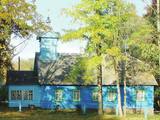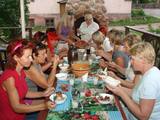| Nr | Name | Beschreibung |
|---|---|---|
|
The handicraft house at Heltermaa harbour is located in the former 18th C tavern, here you can buy local handicrafts and participate in a large number of workshops (making soaps, felting, printing with plants and blocks etc). Open only in summer. |
||
|
Einer der schönsten Gärten in Nica, der besonders Herzblattlilien und Ahornen gewidmet ist. Die Kollektion der Herzblattlilien umfasst mehr als 130 Sorten, während die Zahl der Ahornarten auf 25 gestiegen ist. Am großen Teich kann man Fische füttern und sich an der Schönheit des Gartens erfreuen. Sowohl die Hausherren als auch die Gäste erfreuen sich an der besonderen Wertschätzung, die durch die Kennzeichnung als Preisträger bei Wettbewerben um den schönsten Hof sowohl im regionalen als auch nationalen Maßstab zeugt. |
||
|
A very impressive ensemble that is in terrible shape. The estate dates back to the 18th and 19th century, with the castle being built in the early 19th century. Half a century later it was rebuilt in the Neo-Gothic style with symmetrical towers and bricks in the cornices. The estate belonged to the Manteufel-Stzege dynasty. The vestibule, stairwell and second floor hall still have ornamental ceiling paintings, but visitors are not allowed to enter the building, so they cannot be seen. Valuable interior design elements include a fireplace from the early 19th century that is decorated with marble elements. After the expropriation of the castle in 1920 and until 1951, the building housed a forestry school and then an agricultural crafts school. Opposite the castle was the stable of the state that was built in the style of Classicism with a pediment and mighty columns. Built in the early 19th century, the stable is no longer used and can only be viewed from the outside. A very much overgrown park surrounds the complex, and the hillock is the grave of one of the baron’s dogs.
|
||
|
Das Café befindet sich im Zentrum von Kandava, unweit von dem Marktplatz. Gebäck, Kuchen, Torten, traditionelles Gericht Sklandrausis, Piroggen u.a. |
||
|
Atrodas skaistā vietā – pašā Daugavas krastā. Ēdina, klāj galdus, piedāvā braucienus ar kuģīti pa Daugavu. |
||
|
Das Gotteshaus hat eine nicht traditionelle Planung und Einrichtung: Der Altar befindet sich in der Mitte, aber die Kanzel – über dem Altar. Die Kirche hat einen eigenartigen Glockenturm mit einer im Jahr 1634 gegossenen Glocke. Die heutige Innenausstattung aus Holz haben die Schüler der Handwerkerschule von Riga geschaffen. Neben der Kirche befinden sich die Ruinen der alten Kirche und das Pfarrhaus, wo am Ende des 18. Jhs. als Hauslehrer Garlieb Merkel gearbeitet hat, der das in Liepupe Beobachtete in seinem bedeutenden Werk Letten verwendet hat. |
||
|
Vom 6. – 8. Jh. befand sich an der Stelle der heutigen Stadt Grobiņa die größte in den baltischen Ländern bekannte skandinavische Händler- und Soldatenkolonie. Die Einwanderer aus Gotland und Schweden hatten ihre Inlandsiedlung auf einem Hügel eingerichtet, der sich am Ufer des damals schiffbaren Flusses Ālande befand. Es wird angenommen, dass sich genau hier die in den Chroniken aus dem 9. Jh. erwähnte Burg der Kuren – Seeburg – befand. Nach dem Bau der Ordensburg im 13. Jh. wurde Grobiņa zu einem Kreiszentrum. Die älteste Bebauung der Stadt hat sich um die Lielā Straße, sowie um die Saules Straße und Parka Straße herausgebildet. |
||
|
Bis 1724 gehörte das Gut damals als Vorwerk Cecina der Familie Hylzen. Nachdem die Tochter Jadvyga Jan Szadurski geheiratet hatte erscheint das Gut 1774 in Dokumenten unter dem Namen Malnava. Weiterhin gab es noch mehrere Besitzerwechsel. Das Hauptgebäude des Gutes ist im Stil des Klassizismus errichtet, teilweise mit barocken Zügen. Auf einer Seite des Gutshofes befindet sich ein Speicher, das Herrenhaus befindet sich an der Stirnseite des Hofes. Zum Zeitpunkt der Bodenreform in Lettland 1920 war das Gut Malnava mit 12.400 Heltar eines der größten Güter in Lettland. Das Gutshaus wurde im 2. Weltkrieg zerstört, zwar wurde es wiederaufgebaut, aber die Inneneinrichtung ist nicht erhalten. Von den Wirtschaftsgebäuden ist der aus der ersten Hälfte des 19. Jh. stammende klassizistische Speicher erhalten sowie einige weitere Gebäude. Das Gutsensemble wird von einem Park ergänzt, in dem jetzt immer noch einige fremdländische Bäume und Sträucher wachsen, z.B. ein Amur-Korkbaum. Es gibt auch zwei Stahlbetonbunker, wo Hitler Mal kurze Zeit anwesend war. Auf dem Territorium befindet sich auch die Schnapsbrennerei der Marke „Latgales šmakovka“, wo Besucher sich mit der Herstellung von Hochprozentigem von frühesten Zeiten bis heute bekannt machen können. |
||
|
You will feel the beauty, power and energy of nature here, ensuring harmony with nature and a good sense of the energy of rocks, plants, Latvian plants and underground streams. Rocks here decorate the garden, which offers a good view of the sea and a cascade of waterfalls that are delightful in the spring and the fall. During the summer, it is a rock river. The site is one km to the north of the bus stop in Tūja and has 28 types of coniferous trees, 14 decorative shrubs, 13 kinds of rhododendrons, and winter plants. The interesting collection of stones may mean that there is an energy field, and the garden is quite esoteric. The rocky seashore of Vidzeme is nearby, and the garden has received many prizes from the Salacgrīva Administrative District and Latvia as such. |
||
|
Štikāni Old-Believers Prayer House. The construction works of the church were held in 40s of the 20
th century on the site of the previous church built by brothers Rogozini. You should see Gospel (the protected
art object).
|
||
|
Das Gästehaus befindet sich an dem Ufer des Urstromtales des Flusses Amata. Das Gebäude ist aus natürlichen Materialien (aus den örtlichen Dolomitblöcken) gebaut worden. Hier werden Bio-Speisen angeboten: im Bio-Humus gezüchtete Kartoffeln, Waldbeeren, Waldpilze, ländliche Produkte und grüne Kräuter aus dem eigenen Garten. Lettische Küche: Gebratene und gegrillte Forellen, Rindfleischsteak, Steinpilz- und Pfifferlingsoße. Das besondere Gericht: Der puffige Kuchen von Eglaine aus Bio-Eiern und Kuchen aus Pekannüssen mit Eis. |
||
|
A comparatively large swamp to the North of the Zaļā dune, this is an important place for sulphurous waters, just as is the case with Zaļais swamp. The swamp is cut in two by the 3.5 km Ķemeri-Antiņciems road, from which interesting landscapes can be seen. The road is not appropriate for cars, however. To the East of Raganu swamp is Lake Putnezers, which is difficult to access. There is a small car park with an information stand on the shore of Lake Melnezers alongside the Ķemeri-Jaunķemeri road. The historical and overgrown Old Ķemeri road can be used to get to the seashore from this location. |
||
|
according to legend, was washed into the sea because of collapsing shores along with other buildings and the old road. The church was built in 1862 and has an altar painting from the late 19th century, "Mother of God," along with an organ. The metal elements of the building's doors are interesting. Hanging from the ceiling of the church is a sailing ship that has to do with the rescue of the crew of the sunken ship. |
||
|
Interesantā būve, kurai Baltijas valstīs grūti atrast līdzinieku, ir meklējama 2 km ziemeļaustrumos no Kirblas (Kirbla). 307,8 m garo arkveida tiltu pāri Kazari upei (Kasari jõgi) uzcēla 1904. g. deviņu mēnešu laikā. Tajā brīdī to uzskatīja par Eiropas garāko šāda tipa dzelzsbetona tiltu. Tagad to var šķērsot tikai ar kājām vai ar divriteni. Tumšajā diennakts laikā tilts ir skaisti izgaismots! Tā ievērojamais garums ir skaidrojams ar apstākli, ka pavasara palos Kazari palienes applūst lielās platībā. |
||
|
Hier kann man die traditionellen kurländischen Gerichte genießen: Sklandrausis und Vorort gebackenes Sauerbrot. Im Sommer können Gruppen von Touristen am Kamin im Außenbereich bei der Vorbereitung der Gerichte von Suiti (Knödel, geräucherte Rippen u.a.) teilnehmen oder schon an gedeckten Tischen in der Art von Suiti das Essen, sowie den eindrucksvollen Vortrag (den einzigartigen Gesang Burbons) der Suiti-Frauen genießen. Lettische Küche: Sauerbrot, Knödel, geräucherte Rippen. Das besondere Gericht: Selbstgebackenes, traditionelles Gericht Sklandrausis. |
||
|
Der Fluss ist klein, aber hat ein großes Tal, das von der Straße Vecumnieki – Ilūkste durchquert wird. Der Name des Flusses Vilkupe ist mit dem ehrgeizigen Plan des kurländischen Herzogs Jacob verbunden, die Flüsse der Flussbecken von Daugava und Lielupe zu verbinden. Die Arbeiten an dem Verbindungskanal wurden angefangen, aber das Projekt wurde nicht realisiert. Der Fluss Vilkupe war in diesem Projekt als ein Teil des Verbindungskanals vorgesehen. In Bezug auf diese Tatsache ist es wert, über die Größe der Ideen und Innovationen eines kreativen mittelalterlichen Menschen nachzudenken. Ungefähr 4 km von der Ortschaft Vilkupe ist ein Fragment des Kanals markiert und zu besichtigen. |
||
|
The distance from Riga to Tallinn is more than 300 km and it takes approx. 5 hours by bus. Therefore we suggest stopping on the way for a brief excursion to a herb farm and lunch in a country pub. This stopover is approx. 1.5 hours’ drive from Riga, just at that point when one needs to stretch one’s legs and enjoy a change of scene. The visit will give an insight in rural life and it may surprise visitors to learn how well Latvians understand nature, knowing and using herbs for food, health and beauty. After the excursion, the group will have lunch in a country pub serving meals made from locally grown ingredients. |
||
|
The craftspeople use natural materials to produce rattles, wind chimes and musical instruments. They teach children how to make pipes out of reeds. Aleksandrs has a collection of some 100 different instruments which he knows how to play. You can commission or purchase products from the craftspeople. |
||
|
The restaurant-cafe Moka is situated in Estonia, in the city of Tartu, not far from Tartu university and offers a wide variety of foods. |
||
|
Das Speisehaus Lümanda in alter Kirchschule bietet Ihnen leckeres Bauernmenü an. Beim Kochen wird nur biologisch reine Rohstoffe aus umliegenden Feldern benutzt. Fisch stammt von örtlichen Fischern. Nebenan gibt es ein Handarbeitsgeschäft. |
||



















